Experimental Study on Damage Effect of Mid-Infrared Pulsed Laser on Charge Coupled Device (CCD) and HgCgTe Detectors
Abstract
:1. Introduction
2. Theoretical Model of Laser Irradiation Photodetector
2.1. CCD Detector Laser Irradiation Model
2.2. HgCdTe Detector Laser Irradiation Model
3. Experimental Research on Mid-Infrared Pulsed Laser Damage HgCdTe Detectors
3.1. Experiments on HgCdTe Detectors Damaged by Mid-Infrared Pulsed Laser
3.2. Spot Diameter Measurement to Photodetector
3.3. Experimental Results of Mid-Infrared Pulsed Laser Damage to HgCdTe Photodetector
4. Experiment of Mid-Infrared Pulsed Laser Damage to CCD Detectors
4.1. Transmittance Measurement of Mid-Infrared Laser to CCD Packaging Glass
4.2. Experiment on CCD Detector Damage by Mid-Infrared Pulsed Laser
5. Analysis of Damage Mechanism of Surface Array CCD by Mid-Infrared Pulse Laser
6. Discussion
- The damage threshold of the mid-infrared pulsed laser to the CCD detector fell within the range of 0.883 J/cm2 to 1.892 J/cm2, whereas for the HgCdTe detector, it ranged from 0.412 J/cm2 to 0.953 J/cm2.
- The mid-infrared pulsed laser exhibited a propensity for inducing permanent damage to CCDs, delineated into point damage, line damage, and complete blinding, each with varying impacts on the imaging fidelity. While point and line damage impaired specific regions’ imaging capability, the CCD’s overall functionality remained unaffected.
- The damage mechanism of the mid-infrared pulsed laser on the CCD entailed thermal melting caused by the laser, with varying damage depths and sizes yielding distinct effects. Notably, the out-of-band damage threshold was approximately double that of the in-band damage threshold.
Author Contributions
Funding
Institutional Review Board Statement
Informed Consent Statement
Data Availability Statement
Conflicts of Interest
References
- Xue, X.; Hao, Q.; Chen, M. Very long wave infrared quantum dot photodetector up to 18 μm. Light Sci. Appl. 2024, 13, 89. [Google Scholar] [CrossRef] [PubMed]
- Zhang, C.Z.; Blarre, L.; Walser, R.M.; Becker, M.F. Mechanisms For Laser-Induced Functional Damage To Silicon Charge-Coupled Imaging Sensors. Appl. Opt. 1993, 32, 5201–5210. [Google Scholar] [CrossRef] [PubMed]
- Vasic, A.; Stankovic, S.; Loncar, B. Influence of radiation effects on the electrical characteristics of photodetectors. In Contemporary Studies in Advanced Materials and Processes: Yucomat Iv; Uskokovic, D.P., Battiston, G.A., Milonjic, S.K., Rakovic, D.I., Eds.; Materials Science Forum; Trans Tech Publications Ltd.: Zürich, Switzerland, 2003; Volume 413, pp. 171–174. [Google Scholar]
- Wang, Y.Z.; Cheng, X.Z.; Shao, J.F.; Zheng, C.B.; Chen, A.M.; Zhang, L.W. The Damage Threshold of Multilayer Film Induced by Femtosecond and Picosecond Laser Pulses. Coatings 2022, 12, 251. [Google Scholar] [CrossRef]
- Liu, Y.; Liu, L.; Tang, W.; Shao, J.; Li, X.; Sun, J.; Shao, M.; Cheng, X. Experimental Study on the Damage of Optical Materials by out of Band Composite Laser. Appl. Sci. 2020, 10, 3578. [Google Scholar] [CrossRef]
- Liu, C.; Guo, J.; Yu, L.; Li, J.; Zhang, M.; Li, H.; Shi, Y.; Dai, D. Silicon/2D-material photodetectors: From near-infrared to mid-infrared. Light Sci. Appl. 2021, 10, 123. [Google Scholar] [CrossRef] [PubMed]
- Hou, C.-C.; Chen, H.-M.; Zhang, J.-C.; Zhuo, N.; Huang, Y.-Q.; Hogg, R.A.; Childs, D.T.D.; Ning, J.-Q.; Wang, Z.-G.; Liu, F.-Q.; et al. Near-infrared and mid-infrared semiconductor broadband light emitters. Light Sci. Appl. 2018, 7, 17170. [Google Scholar] [CrossRef] [PubMed]
- Wang, B.; Sakat, E.; Herth, E.; Gromovyi, M.; Bjelajac, A.; Chaste, J.; Patriarche, G.; Boucaud, P.; Boeuf, F.; Pauc, N.; et al. GeSnOI mid-infrared laser technology. Light Sci. Appl. 2021, 10, 232. [Google Scholar] [CrossRef] [PubMed]
- Chua, P.G.; Tanaka, Y.; Takeda, M.; Kurokawa, T. Infrared image detection with a Si-CCD image sensor due to the two-photon absorption process. In Proceedings of the Technical Digest, CLEO/Pacific Rim 2001, 4th Pacific Rim Conference on Lasers and Electro-Optics (Cat. No.01TH8557), Chiba, Japan, 15–19 July 2001. [Google Scholar]
- Loch, M.; Widenhorn, R.; Bodegom, E. Infrared response of charge-coupled devices. In Proceedings of the Sensors and Camera Systems for Scientific and Industrial Applications VI, San Jose, CA, USA, 18–20 January 2005; pp. 201–208. [Google Scholar]
- Geertsema, R.; Akiba, K.; van Beuzekom, M.; Bischoff, T.; Heijhoff, K.; Snoek, H. Charge and temporal characterisation of silicon sensors using a two-photon absorption laser. J. Instrum. 2022, 17, P02023. [Google Scholar] [CrossRef]
- Cai, H.; Cheng, Z.H.; Zhu, H.H.; Zuo, D.L. Fracture mechanisms of Hg0.8Cd0.2Te induced by pulsed TEA-CO2 laser. Appl. Surf. Sci. 2005, 252, 1685–1692. [Google Scholar] [CrossRef]
- Wang, F.; Cheng, X.A. Damage mechanism of Hg1-xCdxTe detector (PV) when laser irradiates. Infrared Laser Eng. 2006, 169–172. [Google Scholar]
- Li, L. Research on Semiconductor Detectors Irradiated by In-Band and Out-of-Band Laser Beams; National University of Defense Technology: Changsha, China, 2011. [Google Scholar]
- Zhang, Y.; Niu, C.H.; Li, X.Y.; Zhang, Q.Y. Research on the Thermal Damage of InSb Infrared Detector under Wavelength of 10.6μm Laser Irradiation. Infrared Technol. 2018, 40, 528–533. [Google Scholar]
- Hu, W.M.; Wang, X.J.; Tian, C.Y. Influence of mid-infrared laser pulse width on in-band damage threshold of HgCdTe. High Power Laser Part. Beams. 2022, 34, 130–137. [Google Scholar]
- Wang, X.; Ye, Q.; Lei, W.H. Experimental study of Pbs detector irradiated by 2.179 μm mid-infrared laser. J. Infrared Millim. Waves 2022, 41, 354–361. [Google Scholar]
- Deng, Y.; Fan, Z.-F.; Zhao, B.-B.; Wang, X.-G.; Zhao, S.; Wu, J.; Grillot, F.; Wang, C. Mid-infrared hyperchaos of interband cascade lasers. Light Sci. Appl. 2022, 11, 7. [Google Scholar] [CrossRef] [PubMed]
- Granger, G.; Bailly, M.; Delahaye, H.; Jimenez, C.; Tiliouine, I.; Leventoux, Y.; Orlianges, J.C.; Couderc, V.; Gérard, B.; Becheker, R.J.L. GaAs-chip-based mid-infrared supercontinuum generation. Light Sci. Appl. 2023, 12, 252. [Google Scholar] [CrossRef]
- Academy, T. Some characteristics of infrared jam and its simulation technique on infrared guided missile. Infrared Laser Eng. 2001, 30, 241–245. [Google Scholar]
- Jha, A. A review of visible, near-IR and mid-IR transitions in Rare-earth doped glass waveguides for remote sensing and LIDAR —Art. no. 640918. In Proceedings of the Conference on Lidar Remote Sensing for Environmental Monitoring VII, Goa, India, 14–16 November 2006; p. 40918. [Google Scholar]
- Yasa, U.G.; Bozat, O.; Figen, Z.G.; Bozbulut, A.R. Investigation of the influence of optical turbulence on DIRCM laser’s jamming effectiveness: A wave-optics approach. Infrared Phys. Technol. 2021, 115, 103728. [Google Scholar] [CrossRef]
- Kim, S.; Shin, J.; Kim, S. AT2ES: Simultaneous Atmospheric Transmittance-Temperature-Emissivity Separation Using Online Upper Midwave Infrared Hyperspectral Images. Remote Sens. 2021, 13, 1249. [Google Scholar] [CrossRef]
- Hu, B.; Sun, D.; Liu, Y. A Novel Method to Remove Fringes for Dispersive Hyperspectral VNIR Imagers Using Back-Illuminated CCDs. Remote Sens. 2018, 10, 79. [Google Scholar] [CrossRef]
- Ji, Y.; Xu, W.; Ding, N.; Yang, H.; Song, H.; Liu, Q.; Agren, H.; Widengren, J.; Liu, H. Huge upconversion luminescence enhancement by a cascade optical field modulation strategy facilitating selective multispectral narrow-band near-infrared photodetection. Light Sci. Appl. 2020, 9, 184. [Google Scholar] [CrossRef]
- Bartoli, F.; Esterowitz, L.; Kruer, M.; Allen, R. Thermal modelling of laser damage in 8–14 μm HgCdTe photoconductive and PbSnTe photovoltaic detectors. J. Appl. Phys. 1975, 46, 4519–4525. [Google Scholar] [CrossRef]
- Bartoli, F.; Esterowitz, L.; Allen, R.; Kruer, M. Generalized Thermal Model For Laser Damage In Infrared Detectors. J. Appl. Phys. 1976, 47, 2875–2881. [Google Scholar] [CrossRef]
- Bartoli, F.; Esterowitz, L.; Kruer, M.; Allen, R. Irreversible Laser Damage In Ir Detector Materials. Appl. Opt. 1977, 16, 2934–2937. [Google Scholar] [CrossRef] [PubMed]
- Garnov, S.V.; Epifanov, A.S.; Klimentov, S.M.; Manenkov, A.A. Pulse width dependence of laser induced damage in optical materials: Critical analysis of available data and recent results for nano-picosecond region. Proc. SPIE Int. Soc. Opt. Eng. 1993, 1848, 403. [Google Scholar]
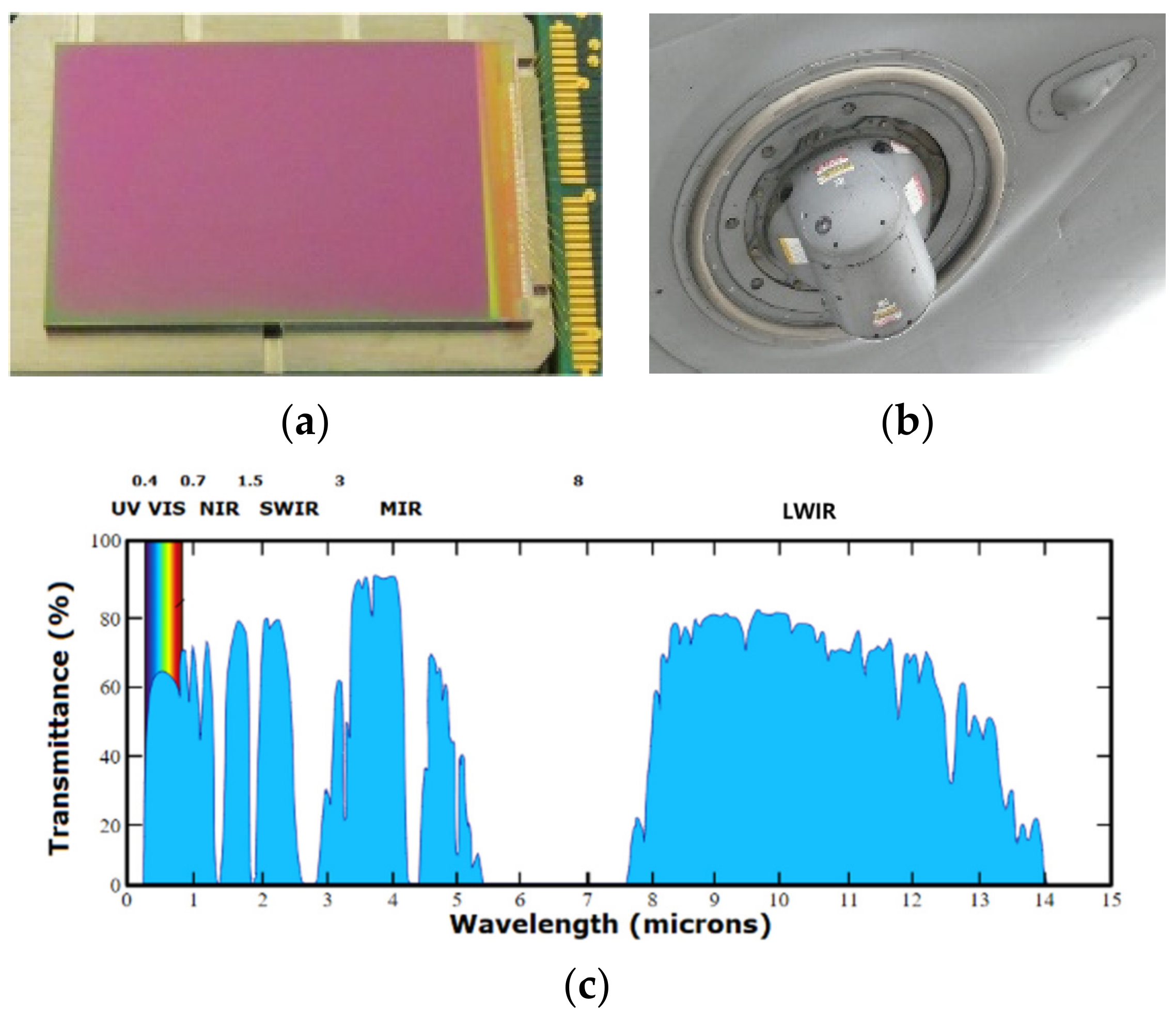
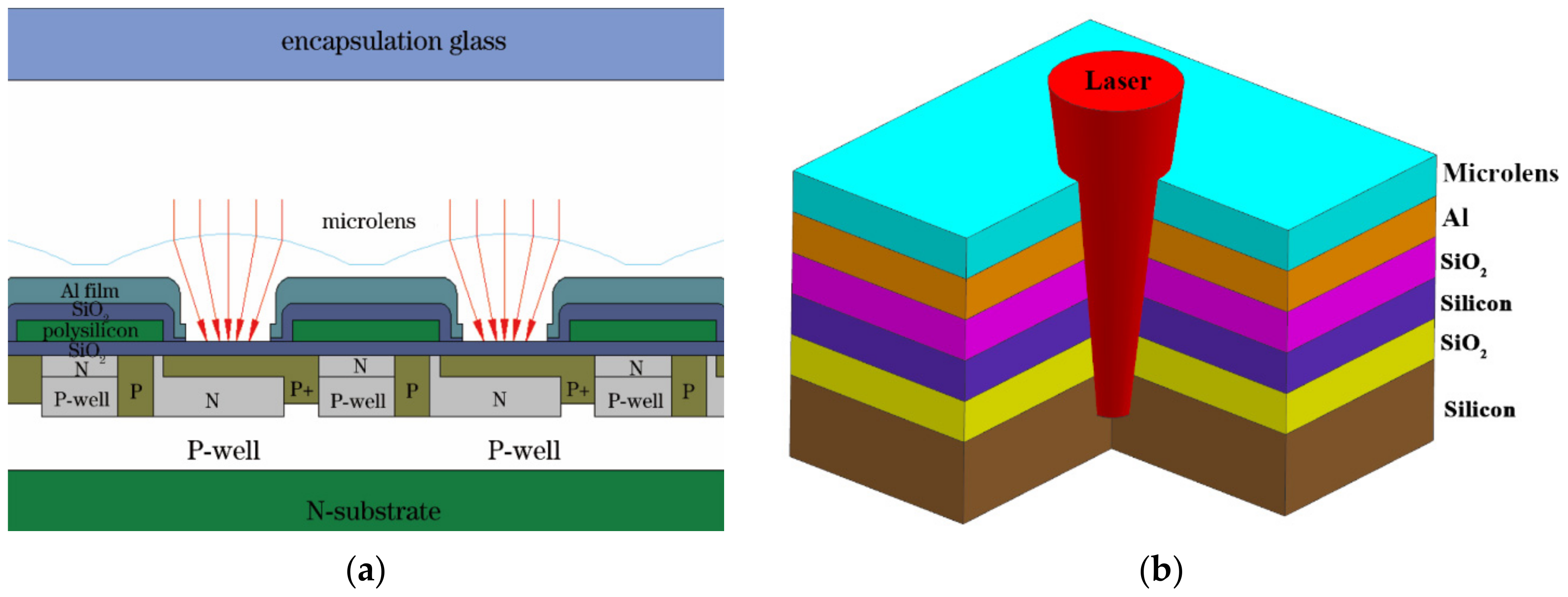

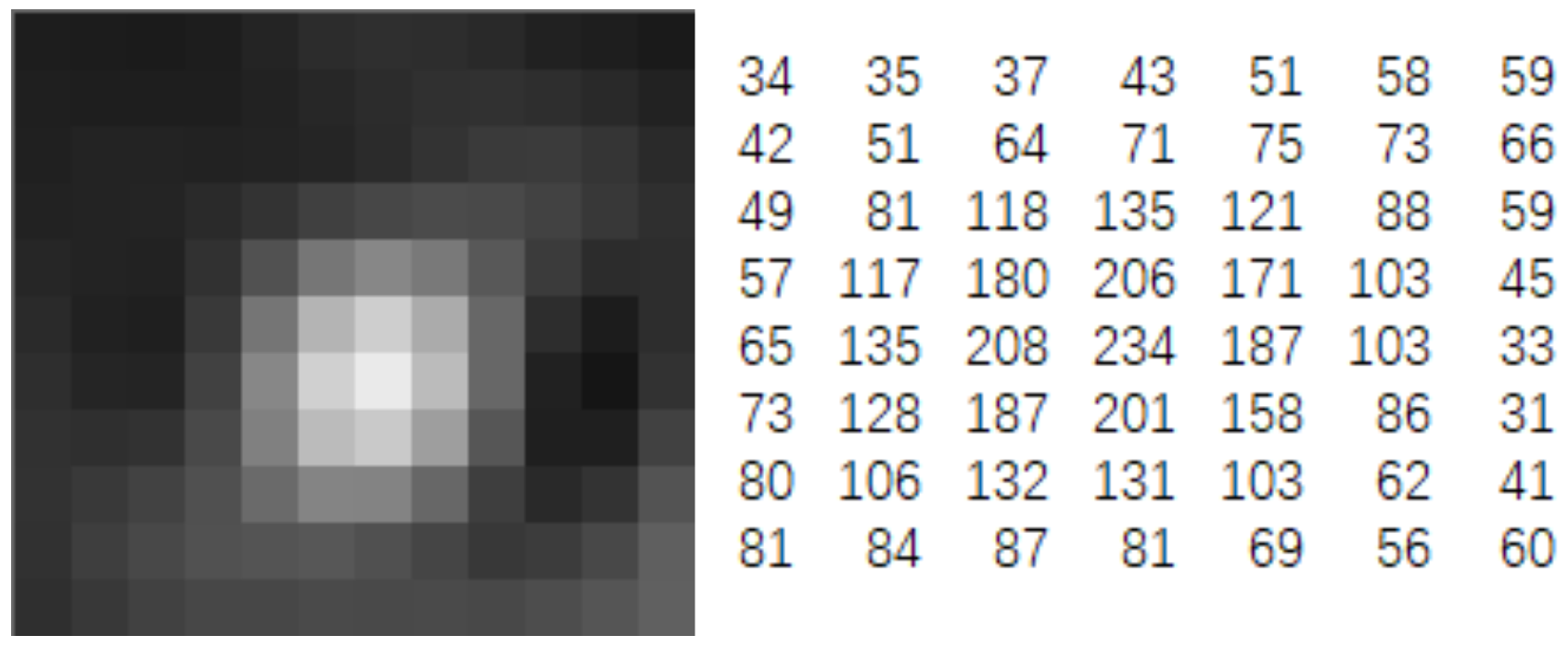



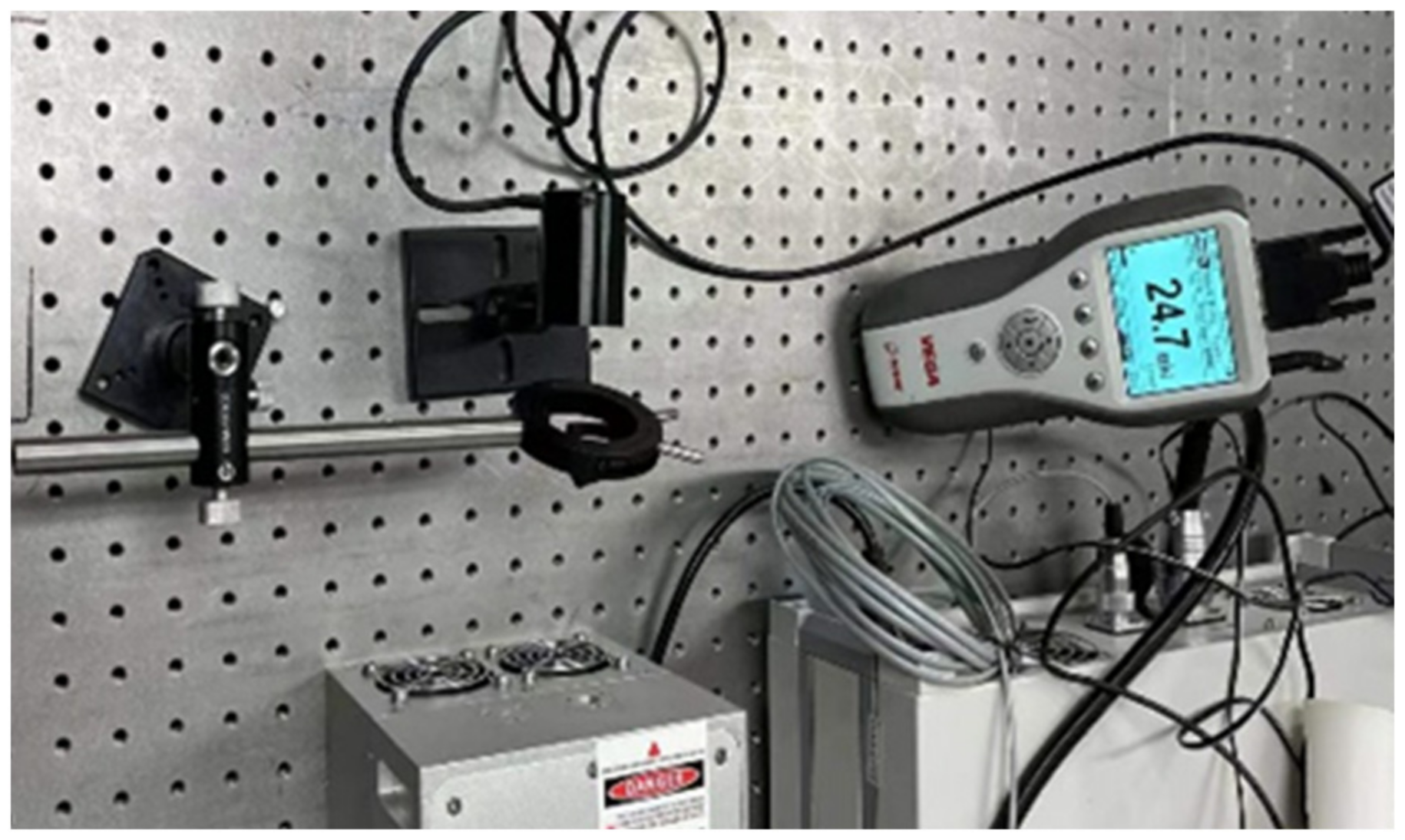
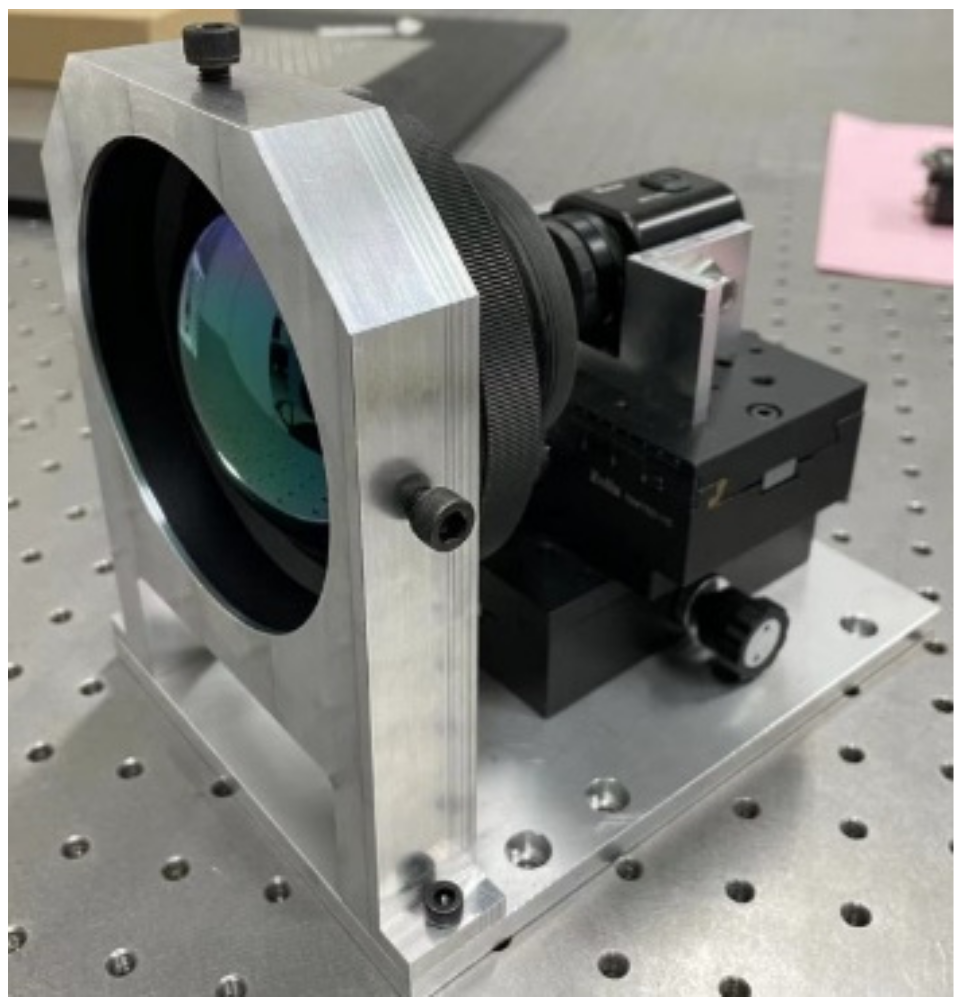
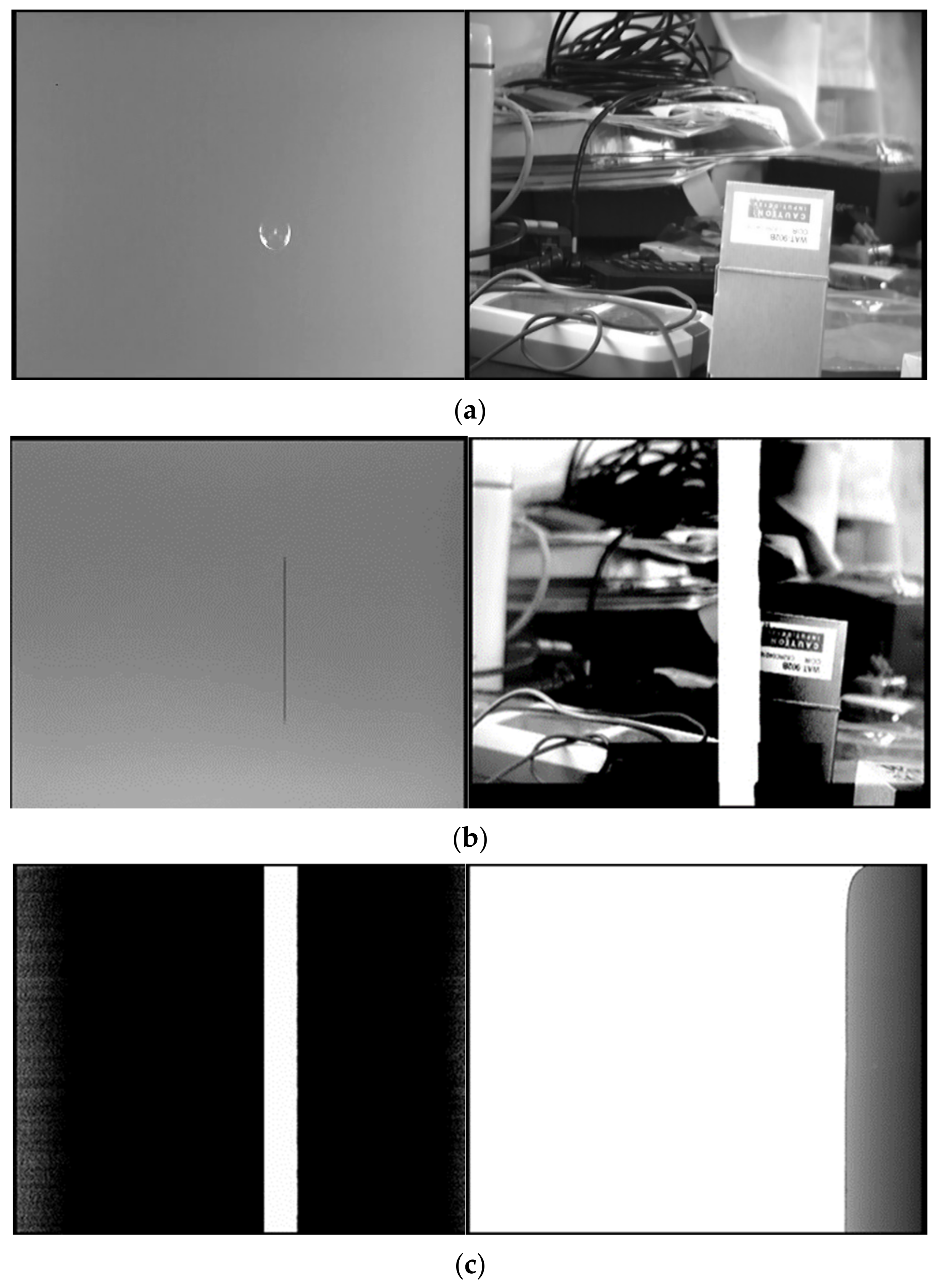
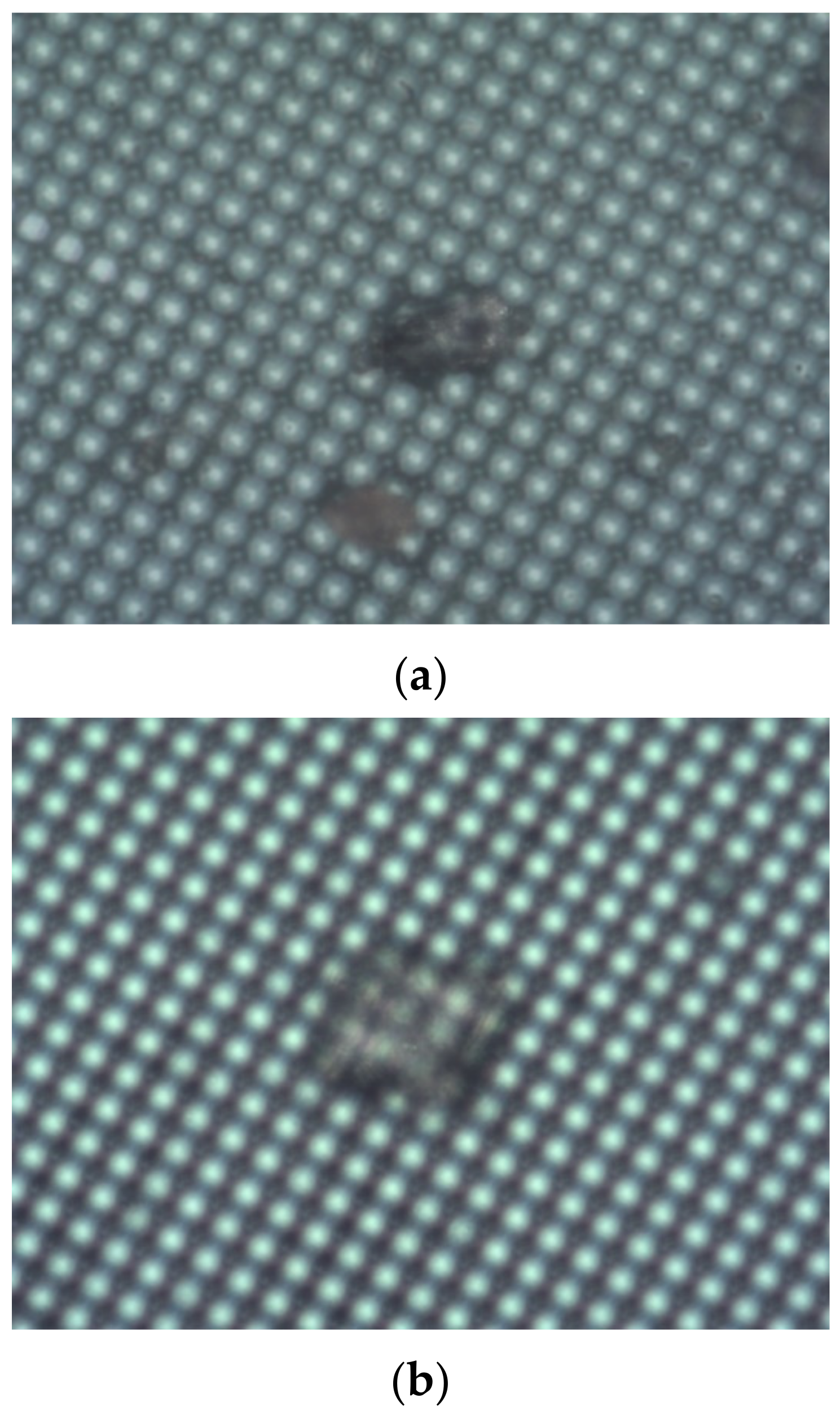
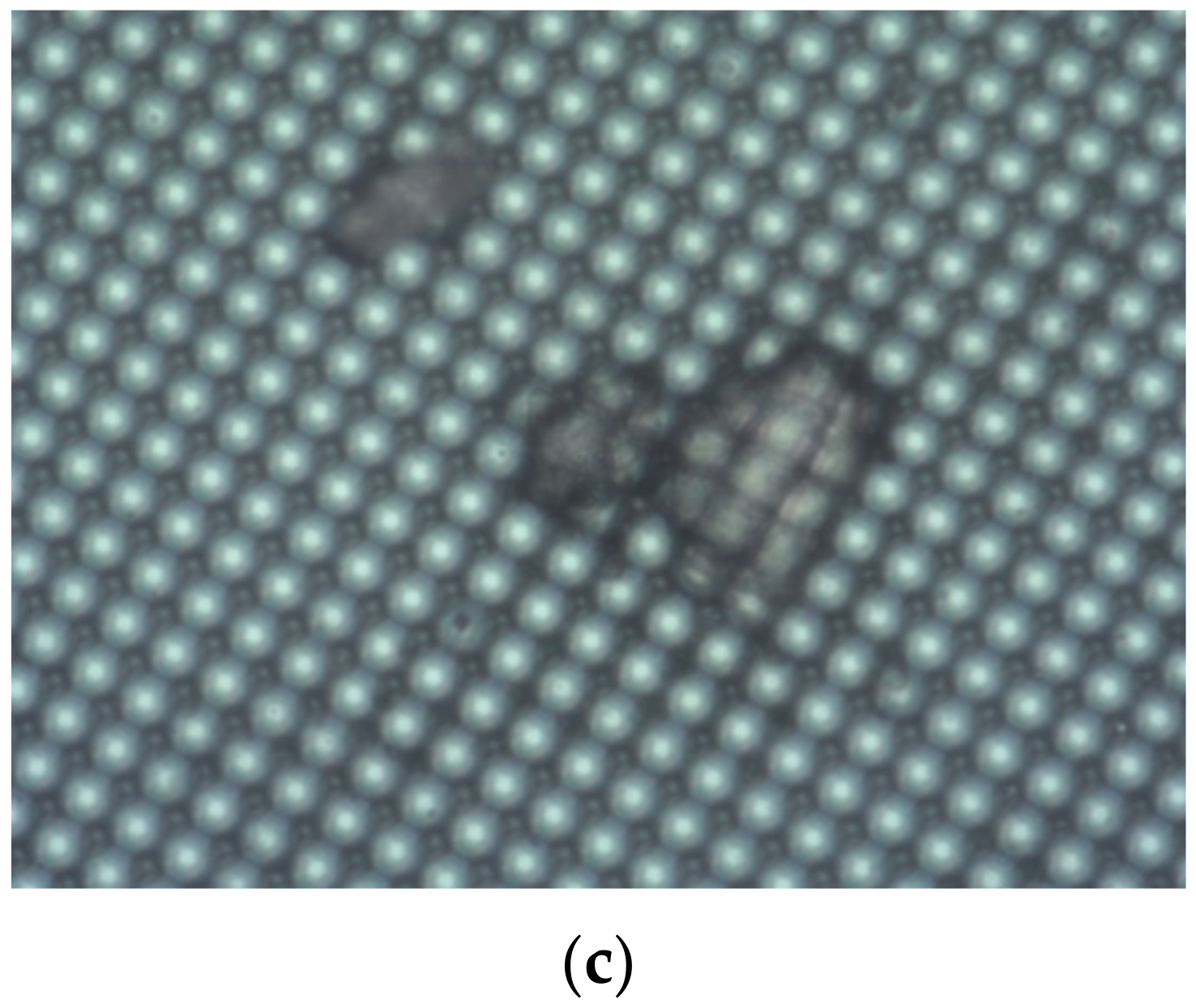
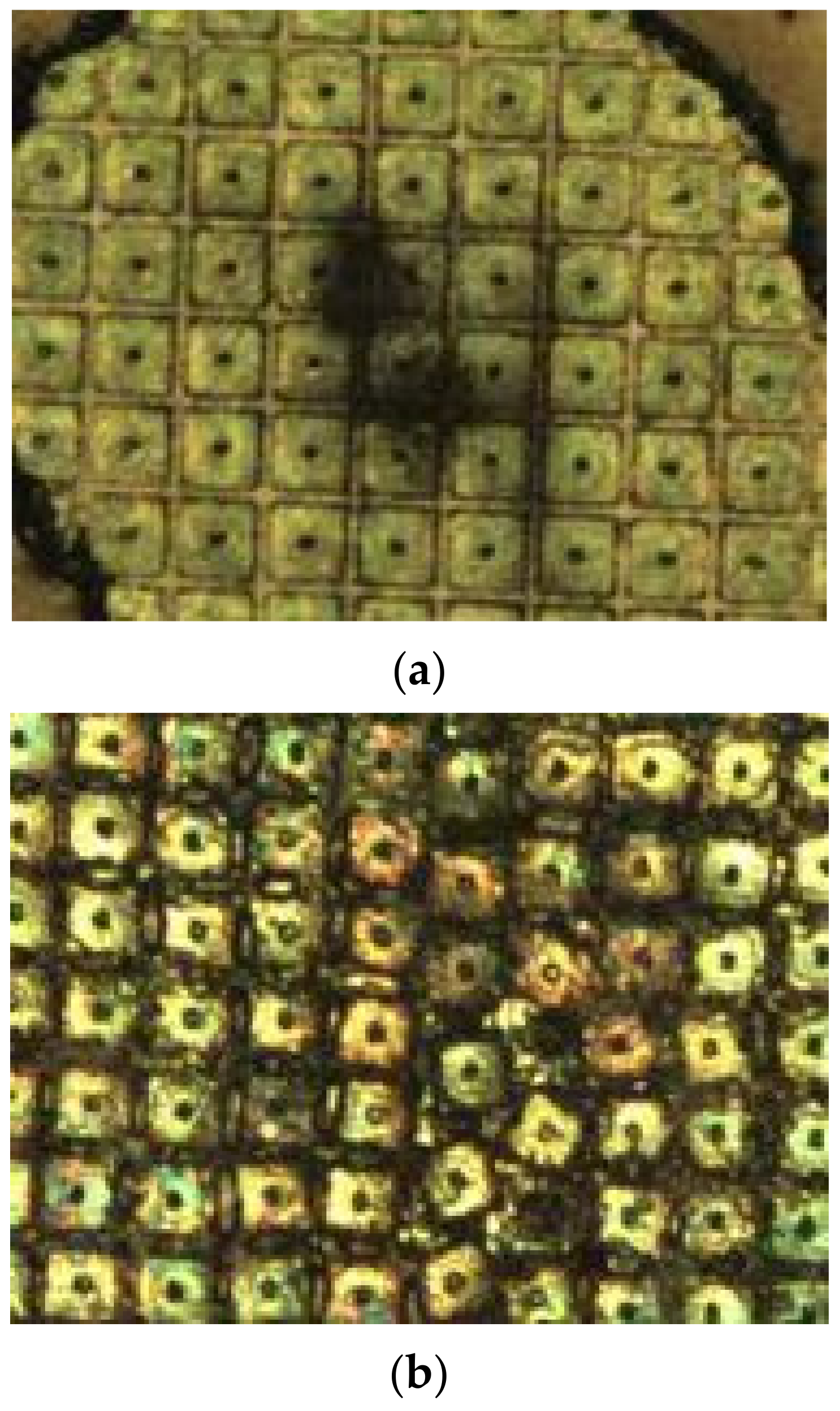
| Parameter | Value | Parameter | Value |
|---|---|---|---|
| Wavelength | 3.8 μm | c | 0.15 J·g−1K−1 |
| k | 0.09 cm2s−1 | τ | 150 ns |
| ΔT | 916 K | α | 2379 cm−1 |
| R | 0.31 | a0 | 85 μm |
| Device | Device Parameters |
|---|---|
| HgCdTe detectors | Pixel size: 30 μm × 30 μm Resolution: 320 × 256 Frame rate: 100 FPS Integration time: 3 ms |
| Mid-IR lens | F: 2 Focal length: 100 mm Lens diameter: 50 mm |
| Mid-IR beam expander | Structure: Off-axis reflective Expansion: 10× Input beam diameter: 20 mm |
| DF laser | Center wavelength: 3.8 μm Maximum single pulse energy: 3.03 J Pulse width: 135 ns Maximum repetition rate: 50 Hz Initial divergence angle: ~10 mrad |
| Power meter 1 | Spectral range: 0.19–20 μm Power range: 20 μW–2 W Energy range: 20 μJ–2 J |
| Power meter 2 | Spectral range: 0.19–20 μm Power range: 150 mW–250 W Energy range: 80 mJ–10 J |
| Mid-IR attenuator | Structure: Reflective attenuator |
| Laser Output Energy | Energy Detected by the Power Meter | Transmittance |
|---|---|---|
| 170 mW | 140.9 mW | 82.9% |
| Laser Diameter | Laser Energy | Damage Phenomenon | Damage Threshold |
|---|---|---|---|
| 210 μm | 0.142 mJ | Point damage | 0.412 J/cm2 |
| 210 μm | 0.190 mJ | Line damage | 0.551 J/cm2 |
| 210 μm | 0.284 mJ | Complete damage | 0.953 J/cm2 |
| Laser Diameter | Laser Energy | Damage Phenomenon | Damage Threshold |
|---|---|---|---|
| 210 μm | 0.304 mJ | Point damage | 0.883 J/cm2 |
| 210 μm | 0.353 mJ | Line damage | 1.019 J/cm2 |
| 210 μm | 0.655 mJ | Complete damage | 1.892 J/cm2 |
Disclaimer/Publisher’s Note: The statements, opinions and data contained in all publications are solely those of the individual author(s) and contributor(s) and not of MDPI and/or the editor(s). MDPI and/or the editor(s) disclaim responsibility for any injury to people or property resulting from any ideas, methods, instructions or products referred to in the content. |
© 2024 by the authors. Licensee MDPI, Basel, Switzerland. This article is an open access article distributed under the terms and conditions of the Creative Commons Attribution (CC BY) license (https://creativecommons.org/licenses/by/4.0/).
Share and Cite
Liu, Y.; Zhou, F.; Wang, Y.; Zhang, Y.; Zhang, Y.; Zheng, H.; Shao, J. Experimental Study on Damage Effect of Mid-Infrared Pulsed Laser on Charge Coupled Device (CCD) and HgCgTe Detectors. Sensors 2024, 24, 4380. https://doi.org/10.3390/s24134380
Liu Y, Zhou F, Wang Y, Zhang Y, Zhang Y, Zheng H, Shao J. Experimental Study on Damage Effect of Mid-Infrared Pulsed Laser on Charge Coupled Device (CCD) and HgCgTe Detectors. Sensors. 2024; 24(13):4380. https://doi.org/10.3390/s24134380
Chicago/Turabian StyleLiu, Yang, Feng Zhou, Yunzhe Wang, Yin Zhang, Yunfeng Zhang, Hanyu Zheng, and Junfeng Shao. 2024. "Experimental Study on Damage Effect of Mid-Infrared Pulsed Laser on Charge Coupled Device (CCD) and HgCgTe Detectors" Sensors 24, no. 13: 4380. https://doi.org/10.3390/s24134380





